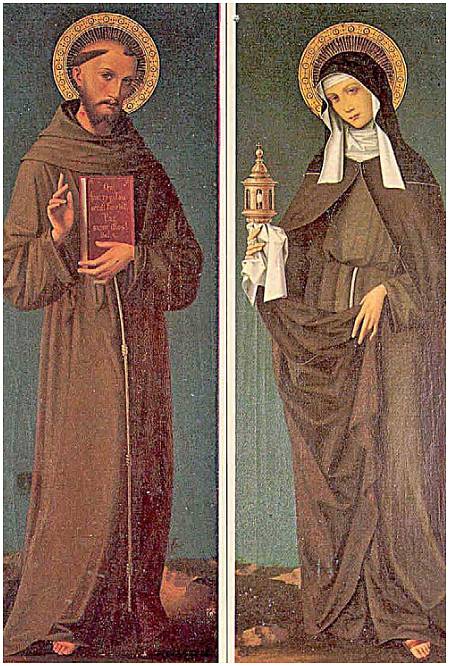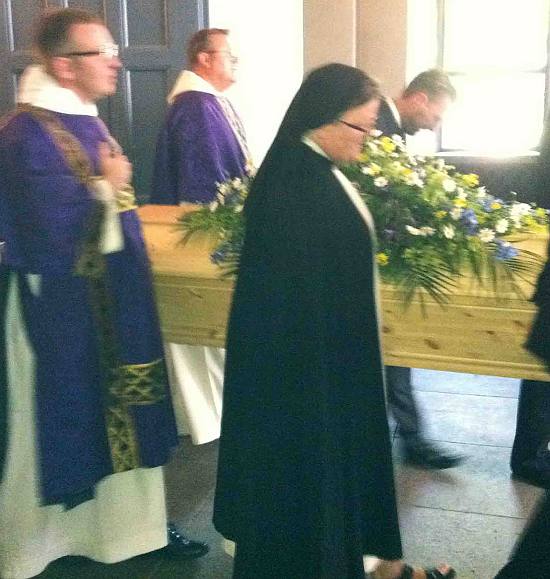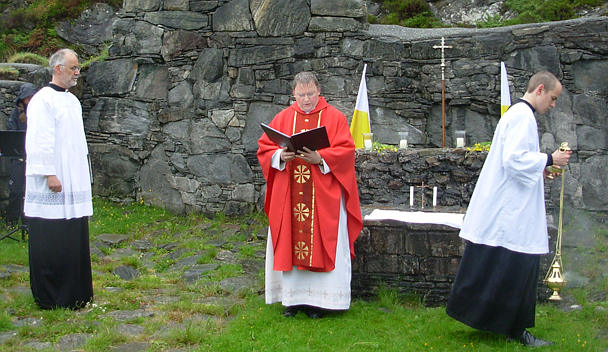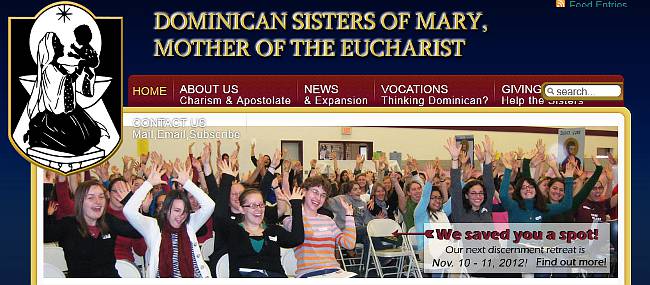Frans’ og Klaras omvendelse

Slik skrev jeg høsten 2011 i vårt menighetsblad Hallvardsvaka, og jeg leste det nylig igjen, siden jeg forbereder et stykke til denne høstens nummer:
Kirken feirer minnedagen for den hellige Frans av Assisi 4. oktober hvert år, så derfor passer det å skrive litt om ham i dette nummeret av Hallvardsvaka. Selvsagt kan man ikke si mye om en så sentral helgen på bare én side, spesielt ikke i St Hallvard menighet, som ble tatt hånd om av fransiskanerprester i over 70 år. Jeg vil derfor bare si litt om starten på hans liv og om hans omvendelse.
Jeg har vært i Assisi to ganger (en tredje gang var jeg i Spello og i Perugia, byer rett sør og nord for Assisi), og spesielt den andre gangen ble det tydelig for meg hvor radikal Frans’, og Klaras, omvendelse var. For jeg opplevde at Klaras liv og hennes omvendelse var like dramatisk og aktuell som Frans’. Og jeg syns disse to unge menneskene fra rike familier, som hadde alt de kunne ønske av jordisk gods og gull, passer godt som rollemodeller for vår tid – for mennesker som også nå har alt de trenger, men likevel søker en dypere forståelse av hvorfor vi lever, og en sterkere innvielse til å tjene Gud og våre medmennesker.
Slik kan vi lese om begynnelsen av Frans’ liv (på katolsk.no): «Den hellige Frans ble født i Assisi i Umbria i Italia tidlig i 1182 som sønn av den rike tøyhandleren Pietro Bernardone og hans kone Johanna Pica. Han lærte latin og fransk, og i ungdomstiden var han en livsglad yngling som levde et overfladisk, sorgløst liv sammen med sine venner. Han hadde mye penger og brukte dem ødselt; han likte det som strålte og tiltrakk seg oppmerksomhet og elsket trubadurenes sanger. Han var et øyeblikkets barn og hans mål var en karriere som ridder og trubadur. …»
Videre kjenner vi (sikkert) til hvordan Frans flere ganger ble utfordret av Herren til å legge jordisk prakt, rikdom og ære bak seg, og til å tjene Herren og bygge opp hans kirke. Han gikk så langt at han til og med ga tilbake alle sine klær til sin far, og begynte å bære en kappe av simpleste stoff.
Og om den hellige Klara kan vi lese (på katolsk.no): «Hun ble født ca 1194 i Assisi i Umbria i den fornemme familien Offreducia. Hun avslo to ekteskapstilbud, det første som 12-åring, men hun besluttet seg ikke endelig til «å forlate verden» før hun kom under innflytelse av den hellige Frans fra sin egen fødeby.
Da hun som 18-åring hørte ham holde en fastepreken i kirken San Giorgio, ble hun så grepet at hun gikk til ham etterpå og ba: «Vis meg veien til Faderen». Han fastla hennes opptagelse til palmesøndag, 18. mars 1212. Men da faren nektet henne å gå i kloster, måtte hun rømme hjemmefra den natten, trolig med samtykke av biskop Guido av Assisi. Hun oppsøke Frans i Portiuncula, fransiskanernes stamkloster tre kilometer nedenfor Assisi, hvor han levde med sin lille kommunitet. Brødrene tok imot henne i sin lille kirke Santa Maria degli Angeli med en prosesjon, brennende lys og oljegrener i hendene. Det sies at Frans på stående fot mottok hennes klosterløfte og klippet håret av henne. …»
Vi som lever et liv på mange måter like bekymringsløst som disse to ungdommene – som levde en fattigere tidsalder, men i svært rike familier – på 1200-tallet, gjør vel i å lære av deres radikale eksempel, og forsøke å leve mer for Gud og våre medmennesker enn for oss selv.


 Forordet til msgr Bux’ bok er skrevet av
Forordet til msgr Bux’ bok er skrevet av 
 I dag, 14. juli, feires den hellige Bonaventura i den tradisjonelle kalenderen, men i 1970 ble han flyttet én dag, til 15. juni – og feires ikke i år siden det er søndag. I de tradisjonelle tidebønnene leste jeg i dag følgende om Bonaventura til Matutin:
I dag, 14. juli, feires den hellige Bonaventura i den tradisjonelle kalenderen, men i 1970 ble han flyttet én dag, til 15. juni – og feires ikke i år siden det er søndag. I de tradisjonelle tidebønnene leste jeg i dag følgende om Bonaventura til Matutin:
 I Ann Arbor, Michigan, har kongregasjonen
I Ann Arbor, Michigan, har kongregasjonen 
